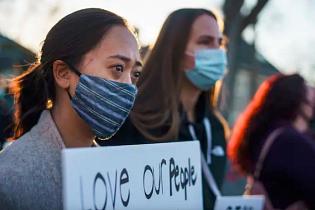Opinion: How churches talk about sexuality can mean life or death. We saw that in Robert Long.
Ideas have consequences. Even the most horrifying events are often the byproducts of convictions and beliefs — ideas put into action. The results can be deadly.
Consider the recent atrocity involving Robert Aaron Long, the 21-year-old man who allegedly murdered six Asian women at massage businesses near his Georgia hometown — an attempt, he told police, to “eliminate temptation.” Long told police that he has a sex addiction and, according to his roommate, viewed himself as an exploited victim of pornography. Notably, this was not a mind-set he apparently extended to the women actually being exploited by both the porn industry and its consumers.
Long was also a baptized member of a Southern Baptist church (SBC). The evangelical denomination is embroiled in controversy over its decades-long mishandling of sexual assault and racial justice. Its most prominent female Bible teacher, Beth Moore, left recently in large part over the denomination’s handling of abuse and treatment of women.
Leaders in both Long’s own church and broader SBC ministry have repudiated the killing of these women, and of course none of them have taught that murder is an acceptable solution to sexual addiction. Yet in a movement struggling with its own difficulties with sexual abuse and its treatment of women and minorities, it’s worth considering whether there are common roots contributing to rotten fruit.
Teachings that place the burden and blame for men’s sexual addictions on women are rampant in conservative theological circles. Assertions that women are both the cause of men’s sexual addictions and the solutions to their sexual needs fill the pages of popular sex and marriage books in evangelical circles, and infiltrate counseling sessions for followers in crisis. Porn addictions are taught as arising when a man’s “need [for sex] is not being met,” while popular teen magazineBrio warned adolescent girls that “If a guy sees a girl walking around in tight clothes, a miniskirt or short shorts, you might as well hang a noose around the neck of his spiritual life.” In conversations about marriage, sexuality and masculinity, women are viewed as both the cause of, and the cure for, men’s sexual aggression.
For generations, conservatives have spoken out against porn culture without seeming to realize they were mirroring the pornographic mind-set. The secular “boys will be boys” mantra was repeated in nearly every mainline Christian book on marriage and purity with the explanation that men got to “sexual sin … naturally — simply by being male.” There is seemingly no understanding that many activities chalked up as “every man’s struggle” are actually crimes and shouldn’t be normalized at all. At the same time, women have often been viewed first and foremost through the lens of their sexuality — characterized either by the danger they posed to a godly man, or as a God-given tool to satiate men so they could avoid the sin of lust.
This is the porn mind-set wrapped in scriptural language.
And yes, it can be deadly.
This is a reality victims and advocates have been raising, literally, for decades. These beliefs have destroyed the lives of the women I know who were counseled to be more sexually available to porn-addicted, abusive husbands to “help him avoid temptation.” The advice didn’t help — it just increased the abuse and control. It destroyed their children, too.
When numerous SBC presidents and leaders ignored and deliberately covered up reports of abuse by prominent pastor Darrell Gilyard, for example, allowing dozens more women and teens to be assaulted, they left destruction in their wake. When just two years ago, the journalism arm of the SBC published an article alleging an affair between a professor and former student at the flagship SBC seminary — in fact the survivor had reported violent sexual assault — it left a woman destroyed.
These perverse sexual teachings have been devastating for hundreds more survivors who bear the brunt of a belief system that sees women as sexual objects — temptresses or tools to satiate male desire — rather than human beings in their own right. The men leading churches, youth groups and seminaries positing the ideas rarely recognize this carnage. Women are left to deal with it.
Sexuality divorced from personhood is the foundation of objectification and violence. The evangelical community has yet to grapple with its own version of this same mind-set and the deep damage it has, and will continue, to do.




